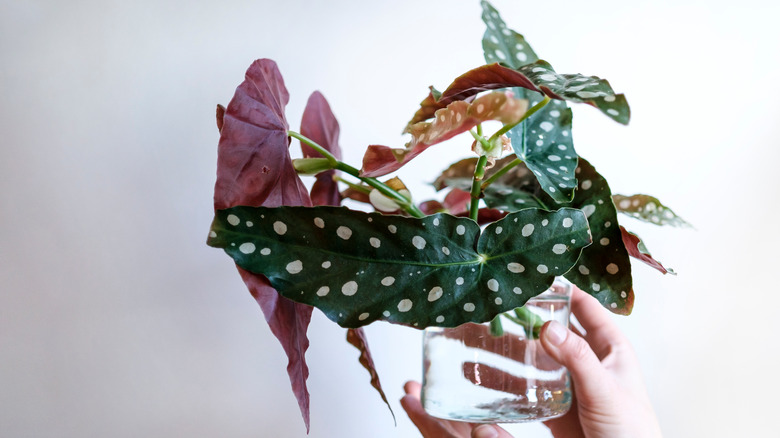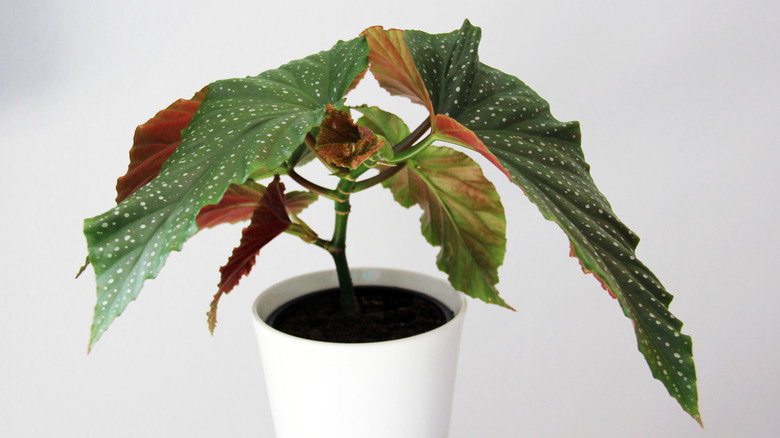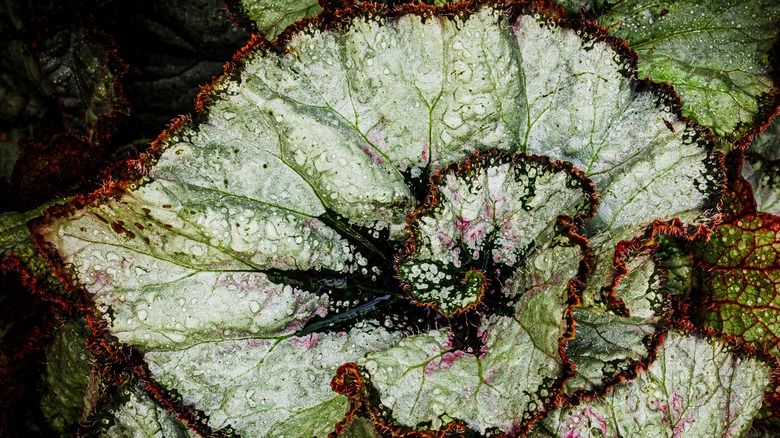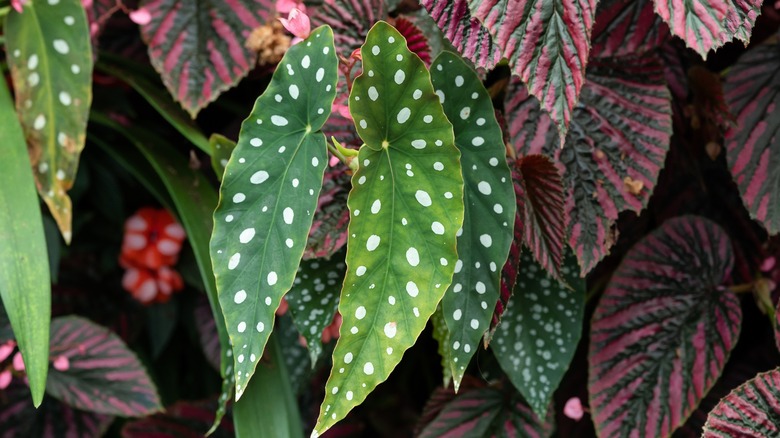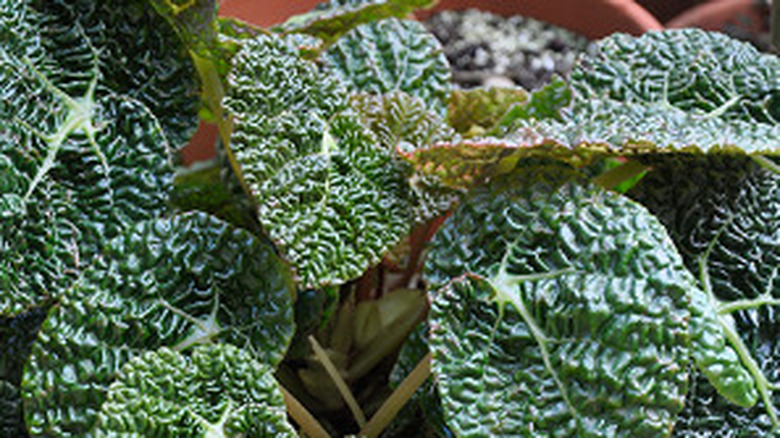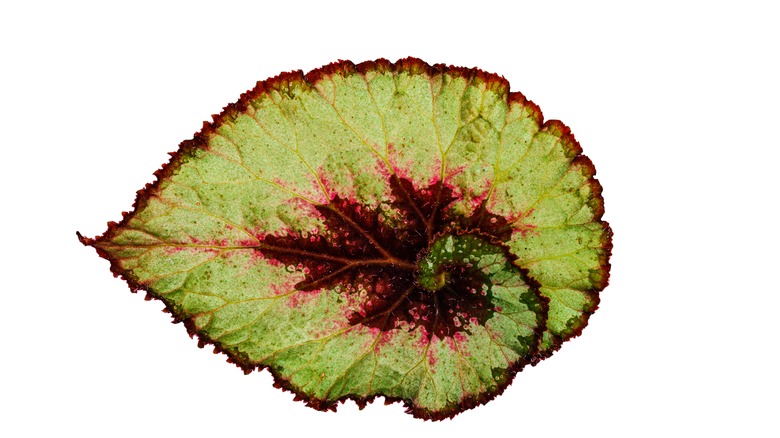5 Easy To Grow Begonias For Your Home
As a popular landscape plant, begonias are considered low-maintenance and an excellent option for bringing color to shady areas. This family of plants is also pretty easy to grow indoors, but like all plants, they have specific water and light requirements. Plants within the begonia family have three different types of root systems, according to Longfield Gardens. Some varieties evolve from tubers. These cultivars are mostly grown outdoors, providing loads of gorgeous flowers throughout the growing season. Begonias are most often cultivated as houseplants grow from root balls or rhizomes.
The begonia family of plants is vast, with over 1,000 species worldwide, states Little Flower Hut. Like many houseplants, begonias are tropical. Early records show that varieties of this plant family were discovered in China around the 14th century, while other cultivars have documentation dating to 1690 in Brazil. These plants have been cultivated worldwide for centuries and are still collected by houseplant enthusiasts because they are beautiful and easy to grow.
1. Angel wing
Angel wing begonias (Begonia 'Angel Wing') are popular cultivars because they grow well in low-light conditions and can tolerate some neglect. In ideal growing conditions with bright, indirect light, Houseplant411 states begonias will bloom with large clusters of gorgeous heart-shaped flowers. Although they may not bloom with less sun, they still produce the beautiful foliage they are known for. The backs of their large leaves are dark red, while the front has a lovely pattern featuring a shimmery metallic sheen. Since they have a cane growth habit, they can be pruned frequently for a full, bushy look or allowed to grow up to 5 feet tall. You can easily root pruned pieces in water for more houseplants or to give as gifts.
To care for your angel wing begonia, water when the soil is dry one inch below the surface. Do not water too often because these plants will get root rot in soggy soil. Fertilize monthly in the spring and summer to encourage your plant to bloom.
2. Rex begonia
The name rex begonia (Begonia 'rex') is an umbrella term for a group of rhizomatous begonias known for their showy foliage, according to Fine Gardening. Members of this family have similar growth habits. They are mounding plants that grow up to about 18 inches tall with striking color palettes, including red, purple, and even black. Their limited size at maturity makes the rex begonia a lovely addition to shelves and tabletops. Although they will bloom even in low-to-mid lighting conditions, their delicate blooms pale compared to their vibrant colors. To get the most from your rex, consider adding it to a collection of plants like spider plants and pothos to make those colors pop.
Rex begonias are easy to grow indoors, states Costa Farms. Their colors are the most vibrant in medium to bright indirect light, so a spot near a sunny window is ideal but not essential for the plant to survive. Water only when the soil is dry to prevent the rhizomes from rotting, and select a planter and a planting medium that offer good drainage. These easy-going plants only require fertilization a few times a year, but you can feed them more often to promote faster growth.
3. Polka dot
Polka dot begonias (Begonia maculata) are similar to angel wing varieties in growth habits and leaf shape, but there are some differences. The pattern on the polka dot plant is more vibrant than that of the angel wing, offering the bright white round spots that give this plant its name. The leaves are also a little more narrow and elongated. Polka dot begonias do not bloom as prolifically as the angel wing, although Mod and Mint say it will produce pretty pink or white flowers when placed in bright, indirect light.
Care requirements for the polka dot begonia are similar to the angel wing variety. Keep the soil moist but not soggy, and place your new plant in a pot with good drainage. Fertilize your polka dot begonia every few weeks in the spring and summer to encourage new growth, but stop fertilizing in the winter to allow the plant to rest up for the next season.
4. Crinkle Leaf
If you are into rare and unusual plants, the crinkle leaf begonia (Begonia moysesii) is a less common variety than others on this list. This native of Brazil has leaves shaped like lily pads with a distinct crinkle pattern that can add interest and texture to your home, according to Plant Lust. At a maximum height of about 12 inches, this sweet little plant can fit just about anywhere. Like the rex begonia, the crinkle leaf cultivar is a rhizomatous plant that comes in a variety of colors, from solid green to dusky orange. You are unlike to find this begonia at your local garden center, but you might get lucky and find one at your local specialty plant nursery or online sellers.
Crinkle leaf begonias are just as easy to care for as any other. They need well-drained soil and will tolerate low-light conditions. In bright, indirect light, they may produce small white flowers.
5. Camouflage begonia
Do not be misled by the name of the camouflage begonia (Begonia 'camouflage') — this plant does the very opposite of blending in. The National Gardening Association states this rhizomatous plant offers showy blooms in the right growing conditions, but this plant's foliage is gorgeous even when not in bloom. The camouflage begonia offers deeply textured, dark green leaves with a deep red that runs along the veins. Like the crinkle leaf variety, this begonia is pretty rare and may be difficult to find locally, but when you do, it will certainly be worth the hunt!
Because it is a rhizomatous plant, you must provide your unique camouflage begonia in a planting medium that offers good drainage. The blooms of this plant are particularly appealing to bees, so consider placing it outside in the shade during the summer months so everyone can enjoy its beautiful flowers. Fertilize every few weeks while your plant is outdoors to keep it flowering.
